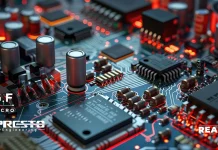With the increasing demand for high-performance electronic devices, the challenge of managing heat dissipation has become a pressing concern. Traditional cooling methods often rely on noisy and energy-consuming fans, which can be a drawback in many applications.
However, there is a solution that offers efficient heat management without the need for fans – fanless heat sinks. These innovative cooling systems utilize advanced thermal designs to effectively dissipate heat while maintaining a silent operation. According to Extrapolate, the global fanless heat sinks market is estimated to reach a valuation of $146 million by 2028. Let’s understand more.
What are Fanless Heat Sinks?
Fanless heat sinks are cooling solutions designed to dissipate heat from electronic components without the use of fans. As passive heat sinks, they utilize natural convection and expanded surface areas to transfer heat away from the components. Unlike active heat sinks that rely on fans, these fanless sinks achieve cooling without any moving parts.
Its primary advantage is its silent operation. By eliminating fans, these cooling devices provide noise-free cooling, making them ideal for environments where quietness is essential, such as home theaters, recording studios, or offices. Additionally, they enhance reliability by removing the risk of fan failure, which could otherwise lead to overheating and potential damage to electronic components. Some of the prominent companies include Boyd Corporation, Focus Technology, Shenzhen Lori Technology, ABB, and more.
How Does Fanless Heat Sinks Work?
- Heat Absorption: Fanless sinks are designed to absorb heat from hot components, such as CPUs or other electronic devices.
- Thermal Conductivity: Made from materials with high thermal conductivity, such as copper or aluminum, these heat sinks conduct the absorbed heat through the material.
- Heat Spreading: The heat sink is designed with a large surface area to allow efficient heat spreading, which helps distribute heat evenly across the heat sink.
- Heat Dissipation: The large surface area enables heat to dissipate into the surrounding environment through natural convection, transferring heat to the air surrounding the heat sink.
- Passive Airflow: Some fanless sinks incorporate fins or other structures that promote passive airflow. This airflow, generated by natural convection or external factors, helps carry heat away from the heat sink.
- Whole Casing as a Heat Sink: In certain fanless systems, the entire casing acts as an extended heat sink. Components are arranged to conduct or radiate heat outward, with fins on the outer casing creating passive airflow to aid in cooling.
Can Fanless Heat Sinks Handle High Temperatures?
Fanless heat sinks are designed to effectively handle high temperatures within certain limits. They utilize materials with high thermal conductivity, such as copper or aluminum, to efficiently transfer heat from hot components to the heat sink. The heat is then spread across the heat sink’s large surface area, allowing for effective dissipation into the surrounding environment through natural convection.
However, it is important to consider factors such as the power dissipation of the device, the thermal resistance of the heat sink, and the ambient temperature to ensure that the heat sink is appropriately sized and matched to the specific requirements of the electronic device. By carefully selecting and implementing fanless sinks within their specified operating parameters, they can provide a reliable and silent cooling solution for managing high temperatures in electronic devices.
Use Cases of Fanless Heat Sinks
Here are some key applications:
Consumer Electronics
- Laptops and Tablets: They provide effective and noiseless cooling, making them ideal for portable electronic devices.
- Smartphones: These heat sinks dissipate heat from powerful processors in smartphones, ensuring optimal performance.
Industrial Machinery
- Automation Systems: They ensure reliability and minimize maintenance in industrial automation systems.
- Control Panels: Heat sinks without fans are used to cool electronic components in control panels, enhancing durability.
Medical Devices
- Diagnostic Equipment: These sinks enable noiseless operation in medical devices like MRI machines and X-ray equipment.
- Patient Monitoring Systems: These heat sinks create a quiet environment in devices requiring constant monitoring, ensuring patient comfort.
Automotive Electronics
- Infotainment Systems: Used for cooling processors in automotive infotainment systems while maintaining a noise-free cabin.
- Advanced Driver Assistance Systems (ADAS): Essential for cooling electronic components in ADAS applications where reliability is crucial for safety.
Telecommunications
- Networking Equipment: These sinks provide effective cooling in routers, switches, and other networking devices without generating noise.
- Base Stations: Crucial for cooling electronic components in telecommunications base stations and hubs, ensuring stable communication.
Aerospace and Defense
- Avionics Systems: Employed in aircraft avionics systems to efficiently cool vital electronic components within limited space.
- Military Electronics: Used for silent operation in military applications to maintain stealth and achieve tactical objectives, enhancing mission success.
These diverse applications highlight the versatility and importance of fanless heat sinks in modern technology, offering silent and reliable cooling solutions across various fields.
Concluding
Fanless heat sinks are innovative cooling solutions for electronic devices, providing benefits such as silent operation, reliability, durability, and energy efficiency. However, they have limitations, including lower cooling capacity and higher operating temperatures. Therefore, it is essential to consider specific cooling requirements to determine the most appropriate choice.
Browse More Posts:-
Hydropower Market
Aerosol Filling Machines Market
Airlines Market
Fertilizer Market




